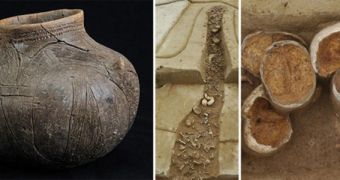Old civilizations can be credited with a lot of things, from setting the basis of modern societies (Sumer), to boosting astronomical knowledge and mathematics. But, at times, the cities and villages inhabited by our ancestors turned into savage grounds, where people would get killed for no apparent reason. This appears to be the case with the Herxheim, located in what is now southern Germany. The settlement was the scene of gruesome crimes more than 7,000 years ago, when its inhabitants seem to have turned into cannibals for a few decades, Wired reports.
Anthropologists and archaeologists working at the location uncovered fragments of bones and skulls from common, oval pits, which seems to suggest that the groups of people living there used to kill and then eat their own members, in cannibalistic rituals. Over the years, experts have tried to find explanations as to why this occurred, but no one managed to come up with a satisfactory idea of what actually happened. A new theory was recently proposed by Bruno Boulestin, who is a French anthropologist based at the University of Bordeaux 1.
He believes that this particular settlement may have been a meeting ground for people in the area. They brought here slaves, war prisoners or other dependents, ritualistically sacrificed them to various gods, and then ate them. Boulestin also believes that a social and political crisis in Europe at the time might have been one of the triggers behind this type of behavior, which, at one point, suddenly stopped. “Human sacrifice at Herxheim is a hypothesis that’s difficult to prove right now, but we have evidence that several hundred people were eaten over a brief period,” the expert reveals.
Analysis of the artifacts recovered from the site shows that the people using the place were a part of the Linear Pottery Culture, a civilization that flourished in Europe between 7,500 and 7,000 years ago. This was the early Neolithic Period, in which farming was just beginning to take hold of the Old Continent. British archaeologist Rick Schulting, from the University of Oxford, remarks that, if further proof of Boulestin's theory can be found, then, “This would be very surprising indeed, simply in terms of the scale involved.” Details of the French anthropologist's work appear in the December issue of Antiquity.
There are, however, those who oppose the new theory. German researchers Jorg Orschiedt, from the University of Leipzig, and Senckenberg Research Institute and Natural History Museum expert Miriam Haidle believe that the site holds evidence of ceremonial reburials. In a statement the two released, they argued that the evidence recovered at the site was more in tune with a scenario in which the flesh was removed from the bones, and then the entire bodies dismembered. They added that ceremonial reburial was a common feat in a large number of ancient societies.

 14 DAY TRIAL //
14 DAY TRIAL //